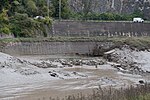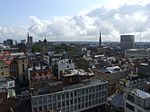St Mary le Port Church, Bristol
15th-century church buildings in EnglandChurches bombed by the Luftwaffe in BristolFormer Church of England church buildingsFormer churches in BristolGrade II listed churches in Bristol ... and 6 more
Grade II listed ruinsRuins in BristolRuins of churches destroyed during World War IIScheduled monuments in BristolUse British English from February 2023World War II sites in England

St Mary le Port is a ruined parish church in the centre of Bristol, England, situated in Castle Park on what remains of Mary le Port Street.
Excerpt from the Wikipedia article St Mary le Port Church, Bristol (License: CC BY-SA 3.0, Authors, Images).St Mary le Port Church, Bristol
Bridge Street, Bristol Broadmead
Geographical coordinates (GPS) Address External links Nearby Places Show on map
Geographical coordinates (GPS)
| Latitude | Longitude |
|---|---|
| N 51.4547 ° | E -2.5916 ° |
Address
Saint Mary-le-Port Church
Bridge Street
BS1 2AW Bristol, Broadmead
England, United Kingdom
Open on Google Maps







